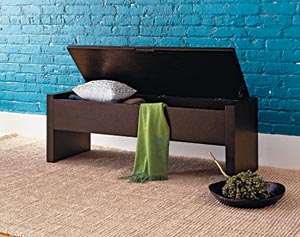Photograph: Thomas Chadwick

|
Stealing Beauty
Brice Cooper, host of HGTV’s Design on a Dime, is not above cruising alleys for furniture finds |
Get started for free.
Why do rooms in CB2 catalogs look so good? You’re not seeing 12 remotes, or piles of magazines (and catalogs). So put stuff away, throw or give away what you don’t want anymore, and clean up. "Say goodbye to that snow globe collection that you didn’t even start," Cooper says. "Then assess the room. What do you love-or hate? What do you use things for?" Design to solve problems: if the plans say dining room but you really need a workroom, make it a workroom.
Make quick fixes.
Update furniture with new knobs-even inexpensive ones can make a big difference. Paint walls or details darker, lighter, or brighter than they’ve been-color is the glue that can hold a room together. "You may have a lot of items that don’t play together well in the sandbox," Cooper says, "but once you make the sand red, they will all get along." Buy or make new covers for throw pillows, and get rid of the ones that aren’t pulling their weight.
 |
|
Bench that doubles as storage, $249, at West Elm
|
Define and stretch your budget.
Be prepared to have a good chunk of even a shoestring budget taken up by a single piece with real design impact, whether it’s a $200 Ikea couch or a vintage Oriental rug purchased at auction for $400. Look for dual-purpose products that help you organize things-if you need an ottoman, make it a storage ottoman. Hang a decorative curtain in front of a closet and spend money on shelving and storage systems. Hide media equipment, disks, wires, cords, and cables in a good-looking cabinet.
Be a patron of the arts.
"Original works of art add elegance to an interior," Cooper says. "Mass-produced, cheaply framed copies do not." Don’t hesitate to spend $150 on a painting or photograph you like at a local coffee shop, art fair, or art-school show. Display it dramatically by using directional lighting or a couple of well-placed pendant lights. Go the extra mile framing your kid’s drawing-choose an elegant mat and frame and give it a place of honor.
Dumpster dive, selectively.
If you smell food, don’t dive! Cruise alleys in the older industrial areas of Chicago-factories throw out some cool things. Cooper says he has found tiles, huge shards of marble, and pieces of slate that make great mosaics this way.
Be a thrift-aholic.
Take a day trip to an older suburb, where local historical societies sometimes have great thrift stores. Cooper especially likes Elmhurst, Sandwich, and Elgin for thrifting. But any store with "thrift" in its name is usually a good deal. Salvation Army stores often have furniture and housewares from many different eras, from the 1930s to the 1990s. Cooper also likes thrift stores associated with agencies, like Children’s Memorial Hospital’s White Elephant resale shop (2380 N. Lincoln Ave.; 773-883-6184) and the Brown Elephant shops (four locations; see www.howardbrown.org) run by the Howard Brown Health Center.
Know trash from treasure.
The difference is always debatable, but if a piece is beyond your means to recondition, forget it. A mid-century modern chair with ripped upholstery and a broken leg probably needs more than a quick fix. Cooper says he recently saw an armoire from the 1970s that was a useful size but made of "weird dark wood, with plastic ornamentation." He would have spent more time and energy getting it into shape than the piece was worth, he figured, so he bought the more expensive piece next to it, instead.
Shop where everyone gets a deal.
Cooper loves HomeGoods stores, with their interesting closeouts from higher-end retailers. "You’ll find great Todd Oldham pieces for La-Z-Boy for more than half off, $15 plates for $4, and candles, pillows, and accent pieces," he says.
Do your homework.
Research styles by perusing books (such as Jonathan Adler’s My Prescription for Anti-Depressive Living) and magazines at your local library. Talk to the guy at the hardware store and learn how to do things yourself. It is easy to wire a lamp, and anyone can paint a room. Get inspiration at stores that are above your price range, then emulate the looks you like with purchases from places you can afford. Cooper especially likes Kmart ("similar styles but better prices than Target").
Become an auction hound.
Auction houses with catalogs often have a "reserve," or minimum price, for each object, but in less formal settings (country auctions, some house sales), the bidding can start anywhere. On-site auctions (restaurants going out of business, for example) have the best deals. "In restaurant auctions, you are ex-posed to things made for durability," Cooper says. "I have seen an entire wood floor go for $10. A polished aluminum pot can make an interesting lamp." Auction Consultants (where he used to work; www.auctionconsultants.net) and Bunte Auctions (www.bunteauction.com) are two reputable companies that handle that type of auction.
|





